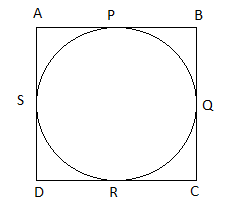
A quadrilateral ABCD is drawn to circumscribe a circle. Prove that \[AB+CD=AD+BC\].
Answer
594.6k+ views
Hint: We will suppose a circle with center as ‘O’ which is circumscribed by quadrilateral ABCD and the quadrilateral touches the circle at four points and then we will use the property of tangents of a circle that the lengths of tangents drawn from the external points are equal.
Complete step-by-step answer:
We have been given a quadrilateral ABCD circumscribing the circle then we have to prove that \[AB+CD=AD+BC\].
Let us suppose a circle with center ‘O’ which is circumscribed by the quadrilateral ABCD and touches the circle at point P, Q, R and S.

As we know that the length of tangents drawn from the external points are equal.
Therefore,
AP=AS…..(1)
BP=BQ…..(2)
DR=DS……(3)
CR=CQ…..(4)
Now adding equation (1), (2), (3) and (4) and we get as follows:
\[AP+BP+DR+CR=AS+BQ+DR+CQ\]
On rearranging the terms we get as follows:
\[\left( AP+BP \right)+\left( DR+CR \right)=\left( AS+DS \right)+\left( BQ+CQ \right)\]
Since we can see from the figure that,
AB=AP+BP
BC=BQ+CQ
CD=CR+DR
AD=AS+SD
Using these values, we get as follows:
AB+CD=AD+BC
Therefore, the required expression is proved.
Note: Remember the point that the length of a tangent from an external point to the circle is equal. In this question without a diagram we are unable to prove the given expression. So first of all draw the diagram according to the question.
Complete step-by-step answer:
We have been given a quadrilateral ABCD circumscribing the circle then we have to prove that \[AB+CD=AD+BC\].
Let us suppose a circle with center ‘O’ which is circumscribed by the quadrilateral ABCD and touches the circle at point P, Q, R and S.

As we know that the length of tangents drawn from the external points are equal.
Therefore,
AP=AS…..(1)
BP=BQ…..(2)
DR=DS……(3)
CR=CQ…..(4)
Now adding equation (1), (2), (3) and (4) and we get as follows:
\[AP+BP+DR+CR=AS+BQ+DR+CQ\]
On rearranging the terms we get as follows:
\[\left( AP+BP \right)+\left( DR+CR \right)=\left( AS+DS \right)+\left( BQ+CQ \right)\]
Since we can see from the figure that,
AB=AP+BP
BC=BQ+CQ
CD=CR+DR
AD=AS+SD
Using these values, we get as follows:
AB+CD=AD+BC
Therefore, the required expression is proved.
Note: Remember the point that the length of a tangent from an external point to the circle is equal. In this question without a diagram we are unable to prove the given expression. So first of all draw the diagram according to the question.
Recently Updated Pages
Two men on either side of the cliff 90m height observe class 10 maths CBSE

What happens to glucose which enters nephron along class 10 biology CBSE

Cutting of the Chinese melon means A The business and class 10 social science CBSE

Write a dialogue with at least ten utterances between class 10 english CBSE

Show an aquatic food chain using the following organisms class 10 biology CBSE

A circle is inscribed in an equilateral triangle and class 10 maths CBSE

Trending doubts
The shortest day of the year in India

Why is there a time difference of about 5 hours between class 10 social science CBSE

Write a letter to the principal requesting him to grant class 10 english CBSE

What is the median of the first 10 natural numbers class 10 maths CBSE

The Equation xxx + 2 is Satisfied when x is Equal to Class 10 Maths

What is the missing number in the sequence 259142027 class 10 maths CBSE




